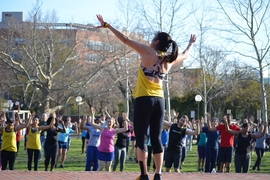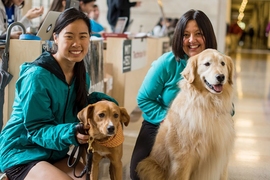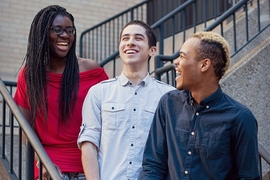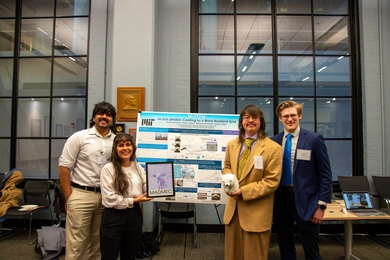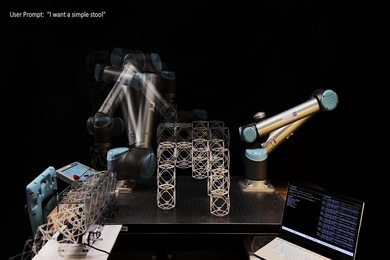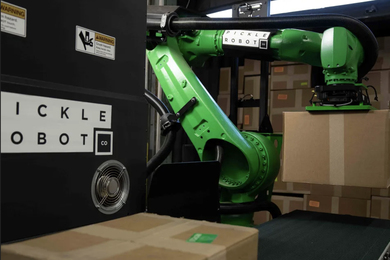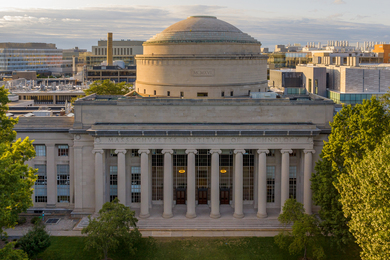It started with a simple Google doc. In the spring of 2015, Mohammad Ghassemi and Tuka Al-Hanai, two graduate students in the MIT Department of Electrical Engineering and Computer Science (EECS), emailed their graduate community a sign-up sheet that read: “MIT Connect pairs members of the graduate student body for platonic, one-on-one lunches once a week over the course of the semester. This form contains a few questions to help match you with others that share your interests and schedule.”
One year, and more than 1,000 lunches later, the two students have launched the “beta edition” of MIT Connect at connected.mit.edu. Grants from the Office of the Dean for Graduate Education (ODGE), the MindHandHeart Initiative, the DeFlorez Fund, and the Legatum Fellowship have all helped Ghassemi and AlHanai to expand the program: MIT Connect is now open to graduate students, undergraduates, and postdocs, as well as all MIT alumni and employees wanting to meet others around campus. To sign up, visit the website and enter your name and MIT ID. Users can then provide their schedule and what they like to eat, and the platform tells them who to meet and when.
“We have been really surprised by the level of interest that Connect has created on campus,” Al-Hanai noted in an evaluation of the program. “We have over 500 students signed up; last fall it was featured in the campus paper; and we were even approached by an investor interested in expanding the service to the public.”
Both student founders specialize in artificial Intelligence, Ghassemi in the context of health care, and Al-Hanai in the context of speech. Their project uses an artificial intelligence algorithm they call the Maven. “Thanks to incredible feedback from users, the algorithm does a pretty good job at matching people,” says Ghassemi. Meanwhile, Al-Hanai reports that “93 percent of participants surveyed rate the program four or above, on a five-point scale, and that 52 percent made a lasting friend using the program.”
Interestingly, Connect was inadvertently inspired by a tragedy. In 2015, Ghassemi was grappling with two deaths that occurred back-to-back, in his hometown and at school. After confiding in his colleague, Al-Hanai, they started asking what personal challenges friends in their community had encountered. Ghassemi and Al-Hanai’s informal polling yielded an unexpected finding: “Time and again,” Ghassemi says, “students would explain how they wanted to find friends, mentors, or co-founders, but found mixers to be impersonal, and sometimes even awkward. One graduate student put it bluntly: ‘Nothing feels worse than going to an event alone and watching everyone else have fun.’”
After discussing with friends ways to reduce isolation and expand social networks on campus, an idea for a solution began to emerge. “One suggestion that came up was to meet with semi-random people during lunch,” says Al-Hanai. “If you were going to take time to eat lunch anyway, you might as well have lunch with someone new. An incredibly interesting person exists out there who might turn out to be your new favorite person.”
The concept moved quickly from idea to action to platform. “We quickly put together a very simple proof-of-concept and received a Graduate Student Life Grant (GSLG) from the Office of the Dean for Graduate Education (ODGE). Then, the pieces starting coming together — from a barebones Google doc to a full-fledged platform.”
For Al-Hanai, creating MIT Connect has been rewarding on many levels. “It’s wonderful to build a system from the ground up that serves the community. I’ve enjoyed learning new technologies, generating visualizations, raising support, and improving MIT Connect’s communications efforts. It’s broadened my sphere of interest. It’s a platform that I myself would use, and it’s fulfilling to hear that my peers are gaining meaningful experiences, connections, and friends through it.”
While MIT Connect has been focused on peer-to-peer pairing, the creators are currently working to launch a version of the platform to help students find mentors, employers, and entrepreneurial co-founders.
Some of the grant funding that supported the growth of MIT Connect is currently available to students, staff, and faculty at MIT: The MindHandHeart Initiative’s Innovation Fund is open for online applications through Oct. 31, and will open again in the spring.



